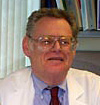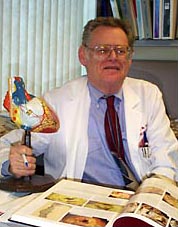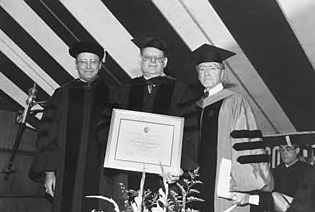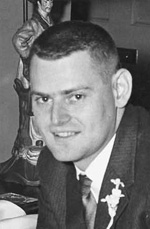
In his 41 years as a professor and electrophysiologist at UCSF, Melvin Scheinman, MD, has shocked thousands of hearts back to health with a procedure called ablation therapy.
But it is the first one, performed in 1981, which stands out most. That shock was born of a single thought - that a catheter, rather than open heart surgery, might be used to fix an irregular heartbeat, or arrhythmia. The shock, a burst of electrical energy, would introduce the era of catheter-based ablation.
Today, the procedure that Scheinman - known as the father of catheter ablation - pioneered at UCSF is performed regularly worldwide. In the United States alone, approximately 20,000 ablations are performed each year, more than 400 of them at UCSF, where it all started.
Success rates tell the story. Catheter ablation is successful in treating 90 percent to 98 percent of arrhythmia cases, according to the American Heart Association, and it has all but eliminated the need for open heart surgery or long-term drug therapy for hundreds of thousands of patients with serious heart rhythm disturbances.
Other Contributions

Scheinman has made a number of other major contributions to the field of cardiology, as well. His team was the first to successfully ablate a certain type of accessory (abnormal) electrical pathway in the heart. He has also devised techniques for successful ablation of sinus node disorders, junctional rhythms and various types of atrial flutter circuits.
In addition, he was the first to define the role of diagnostic procedures for use in patients with bundle-branch block. This work is used worldwide as a guide to permanent pacemaker insertion. He defined the role of pacing and use of an internal defibrillator in patients with long QT syndrome, a congenital abnormality associated with high risk of sudden death, particularly in children and young adults.
Scheinman and his team have also contributed to understanding the mechanism of complex cardiac rhythm disturbances, as well as to defining the role of pharmacologic therapy for patients with serious rhythm disturbances. He led the team that proved the importance of intravenous amiodarone therapy for treatment of unstable, life-threatening ventricular arrhythmias.
"My work has given me a great deal of satisfaction, and to be able to cure a person is truly remarkable," he says. "Just as remarkable as the clinical importance of ablation is the tremendous amount we have learned from it about arrhythmia mechanisms overall."
Most recently, Scheinman has been researching the mechanism of various cardiac rhythm problems involving circuits or unusual pathways. He has completed a sabbatical devoted to understanding molecular biology and genetics, and has started a special clinic devoted to care of patients with genetic causes of sudden cardiac death.
Creating a Standard of Care

|
Scheinman receiving the Distinguished Alumnus Award from Albert Einstein College of Medicine
|
Today, cardiac catheter ablation uses an electrode catheter and radio waves to destroy the faulty electrical tissues in the heart that cause it to beat out of control. Scheinman spent three years of research on the catheter-based approach.
"Back in the 1970s, patients who had an atrial [upper heart] fibrillation had little options if drugs didn't work. The only medical intervention was to have their chest opened and have areas of the heart destroyed directly by cryosurgery [applying extreme cold to destroy tissue] or by surgical division of the atrioventricular junction [an electrical relay station between the upper and lower chambers of the heart]. That was followed by the implantation of a pacemaker."
In 1981, after years of research in the laboratory, Scheinman was ready. His first patient was a retired oil refinery worker who developed pulmonary edema every time he went into atrial fibrillation. Suffering from comorbid conditions, the man was too sick to be a candidate for open heart surgery. "We presented the option to the patient, and he and his wife were the guiding force behind making it a reality." The procedure lasted approximately two hours and was a success.
Impact on Industry
Scheinman's research in catheter ablation also helped to transform the catheter industry. "During experiments, we recognized immediately that we would need a different kind of catheter - one that was more flexible, more malleable. But back then, the catheter companies didn't realize the significance of the procedure, and initially refused to commit resources to make better catheters," he recalls.
That reluctance changed dramatically six or seven years later, when the catheter companies caught on to the significance of Scheinman's work. Today, he reports, the companies routinely update their products every few months. Moreover, they now listen to physician-innovators.
Born in Brooklyn, New York, Scheinman was a gifted student. He entered New York University when he was 16. Originally interested in becoming a biochemist, Scheinman studied biology and biochemistry, and went on to attend Johns Hopkins University in 1954. While there, he realized that life in a laboratory did not suit him. "I couldn't function in a laboratory alone. I needed to interact with people. My adviser at Johns Hopkins was very disappointed when I told him I wanted to go to medical school."

|
Scheinman in Medical School
|
It was during medical school at the Albert Einstein College of Medicine that Scheinman discovered his love of cardiology. "It appealed to me that in cardiology, you could validate your predictions. This wasn't true in most of internal medicine at that time." In 1965, Scheinman became a clinical cardiology trainee at UCSF. Subsequently, he served as director of the coronary care unit at SFGH, and chief of electrocardiography and clinical cardiac electrophysiology at UCSF. He became a full professor of medicine in 1979.
An avid educator, clinician and researcher, Scheinman has published more than 415 peer-reviewed articles, lectured extensively throughout the United States and abroad, and received numerous research and teaching awards. He currently holds the Walter H. Shorenstein Endowed Chair in Cardiology.
"There is still so much to learn," Scheinman says. "I'm sure we're going to have remarkable things happening in the next 10 years. Molecular biology and gene therapy are going to have a tremendous impact. We're all thinking of devices and ablation tools, about making procedures better and cheaper. But I think that in the long haul, it's going to be the molecular jocks that are going to point the way forward."
Scheinman continues to be an integral part of electrophysiology at UCSF, and has no plans for retirement. He sees patients in the clinic and is in the lab at least two days a week. "But teaching is my real love. I intend to keep doing this for the foreseeable future."
Related Links:
Reshaping Faulty Heartbeats with Cell TherapyUCSF Today, November 6, 2006
Fact Sheet: Cardiac Electrophysiology at UCSF
Spotlight Slideshow: New Cardiac Catheterization and Electrophysiology Labs
Tour New Cardiac Labs at UCSF that Are a "First" for California
News Release, October 26, 2006
UCSF Electrophysiology Service
Reflections on the First Catheter Ablation of the Atrioventricular Junction
Melvin A. Scheinman
Pacing and Clinical Electrophysiology 26;2315 December, 2003
Summary |
Full Text |
Full Text (PDF)
Melvin Mayer Scheinman, MD: A Conversation with the Editor
The American Journal of Cardiology 87;5:610-626 March 1, 2001
SummaryPlus |
Full Text |
Full Text (PDF)

 Scheinman has made a number of other major contributions to the field of cardiology, as well. His team was the first to successfully ablate a certain type of accessory (abnormal) electrical pathway in the heart. He has also devised techniques for successful ablation of sinus node disorders, junctional rhythms and various types of atrial flutter circuits.
In addition, he was the first to define the role of diagnostic procedures for use in patients with bundle-branch block. This work is used worldwide as a guide to permanent pacemaker insertion. He defined the role of pacing and use of an internal defibrillator in patients with long QT syndrome, a congenital abnormality associated with high risk of sudden death, particularly in children and young adults.
Scheinman and his team have also contributed to understanding the mechanism of complex cardiac rhythm disturbances, as well as to defining the role of pharmacologic therapy for patients with serious rhythm disturbances. He led the team that proved the importance of intravenous amiodarone therapy for treatment of unstable, life-threatening ventricular arrhythmias.
"My work has given me a great deal of satisfaction, and to be able to cure a person is truly remarkable," he says. "Just as remarkable as the clinical importance of ablation is the tremendous amount we have learned from it about arrhythmia mechanisms overall."
Most recently, Scheinman has been researching the mechanism of various cardiac rhythm problems involving circuits or unusual pathways. He has completed a sabbatical devoted to understanding molecular biology and genetics, and has started a special clinic devoted to care of patients with genetic causes of sudden cardiac death.
Creating a Standard of Care
Scheinman has made a number of other major contributions to the field of cardiology, as well. His team was the first to successfully ablate a certain type of accessory (abnormal) electrical pathway in the heart. He has also devised techniques for successful ablation of sinus node disorders, junctional rhythms and various types of atrial flutter circuits.
In addition, he was the first to define the role of diagnostic procedures for use in patients with bundle-branch block. This work is used worldwide as a guide to permanent pacemaker insertion. He defined the role of pacing and use of an internal defibrillator in patients with long QT syndrome, a congenital abnormality associated with high risk of sudden death, particularly in children and young adults.
Scheinman and his team have also contributed to understanding the mechanism of complex cardiac rhythm disturbances, as well as to defining the role of pharmacologic therapy for patients with serious rhythm disturbances. He led the team that proved the importance of intravenous amiodarone therapy for treatment of unstable, life-threatening ventricular arrhythmias.
"My work has given me a great deal of satisfaction, and to be able to cure a person is truly remarkable," he says. "Just as remarkable as the clinical importance of ablation is the tremendous amount we have learned from it about arrhythmia mechanisms overall."
Most recently, Scheinman has been researching the mechanism of various cardiac rhythm problems involving circuits or unusual pathways. He has completed a sabbatical devoted to understanding molecular biology and genetics, and has started a special clinic devoted to care of patients with genetic causes of sudden cardiac death.
Creating a Standard of Care

